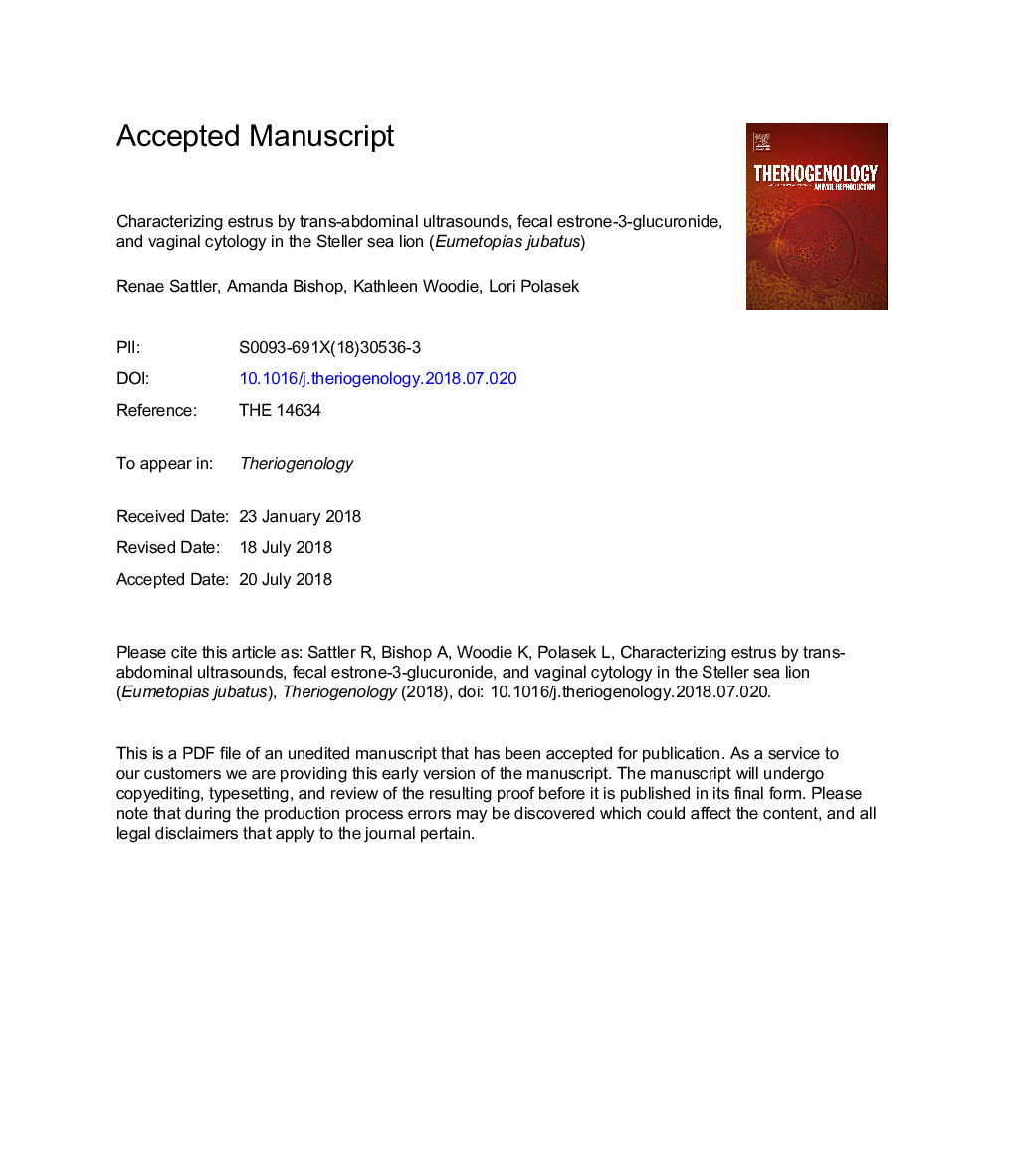| کد مقاله | کد نشریه | سال انتشار | مقاله انگلیسی | نسخه تمام متن |
|---|---|---|---|---|
| 8426048 | 1546049 | 2018 | 32 صفحه PDF | دانلود رایگان |
عنوان انگلیسی مقاله ISI
Characterizing estrus by trans-abdominal ultrasounds, fecal estrone-3-glucuronide, and vaginal cytology in the Steller sea lion (Eumetopias jubatus)
دانلود مقاله + سفارش ترجمه
دانلود مقاله ISI انگلیسی
رایگان برای ایرانیان
کلمات کلیدی
موضوعات مرتبط
علوم زیستی و بیوفناوری
علوم کشاورزی و بیولوژیک
علوم دامی و جانورشناسی
پیش نمایش صفحه اول مقاله

چکیده انگلیسی
The ability to monitor the estrus cycle in wild and captive marine species is important for identifying reproductive failures, ensuring a successful breeding program, and monitoring animal welfare. Minimally invasive sampling methods to monitor estrus in captive populations have been developed, but results suggest these tools can be species-specific in their precision and accuracy. Therefore, the minimally invasive sampling methods of trans-abdominal ultrasounds, a fecal steroid analysis (estrone-3-glucuronide, E1G), and vaginal cytology, were evaluated for their efficacy to characterize and monitor estrus in a captive breeding population of Steller sea lions (Eumetopias jubatus). Three adult females were sampled over five breeding seasons, resulting in six estrus profiles characterized by trans-abdominal ultrasounds, five by fecal E1G, and four by vaginal cytology. Animals were trained to allow trans-abdominal ultrasounds, fecal samples, and vaginal swabs to be collected approximately daily. Of the 76 trans-abdominal ultrasound sessions attempted, 8 successfully visualized both ovaries. From these scans, the chronology of ovarian changes during proestrus and estrus was estimated. The time from the detection of developing follicles to the identification of a dominate follicle occurred in 2-5 days and a corpus hemorrhagicum formed approximately 4 days later. However, because visualization of the ovaries was prevented by the gastrointestinal system in 88% of scans, this tool was overall unreliable for monitoring changes associated with estrus. To detect fine scale physiological changes associated with estrus, we analyzed changes in fecal E1G (nâ¯=â¯62) and vaginal cytology (nâ¯=â¯157) 15 days before and after each female's single copulation event (Dayâ¯=â¯0). Changes in fecal E1G had the highest accuracy at detecting Dayâ¯=â¯0. Fecal E1G increased leading up to estrus, peaked at Dayâ¯=â¯0, and then declined. Although we did observe the characteristic increase in superficial cells associated with impending estrus, the type of cell which peaked closest to Dayâ¯=â¯0 was intermediate. The uncertainty around the peak in intermediate cells, indicating estrus, was greater than the uncertainty associated with detecting estrus from fecal E1G. Collectively, these results suggest that changes in fecal E1G and vaginal cytology are viable tools to detect estrus in Steller sea lions, but require daily sampling to detect gradual changes, limiting their applicability to studies of wild populations.
ناشر
Database: Elsevier - ScienceDirect (ساینس دایرکت)
Journal: Theriogenology - Volume 120, 15 October 2018, Pages 25-32
Journal: Theriogenology - Volume 120, 15 October 2018, Pages 25-32
نویسندگان
Renae Sattler, Amanda Bishop, Kathleen Woodie, Lori Polasek,